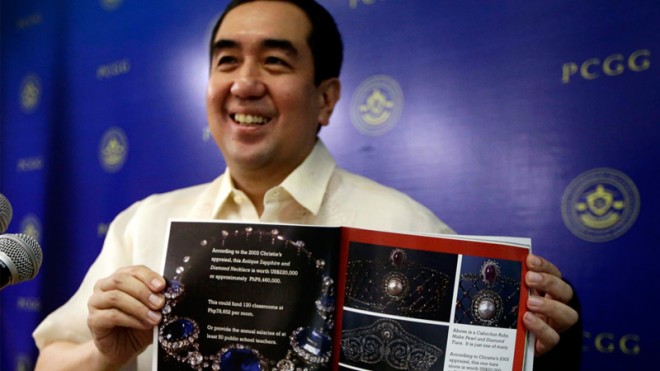Imelda Marcos jewels now worth P1B

Andres Bautista, then chairman of the Presidential Commission on Good Government, which is tasked with recovering the alleged ill-gotten wealth of the late dictator Ferdinand Marcos and his family, shows a catalog of a seized jewelry collection belonging to the Marcoses at a news conference Tuesday, Jan. 14, 2014. The antigraft court has ruled the collection is ill-gotten. AP PHOTO/BULLIT MARQUEZ
The jewelry pieces that once complemented the bright and colorful dresses of former first lady Imelda Marcos are now worth at least P1 billion.
The Presidential Commission on Good Government (PCGG) on Friday said the value of the three Marcos jewelry collections seized by the government following the fall of the dictatorship in 1986 has “significantly increased,” with a number of the pieces worth 10 times more than their value three decades ago.
Auction houses Christie’s and Sotheby’s estimated the Hawaii, Malacañang and Roumeliotes jewelry collections to be worth “at least P1 billion,” the PCGG said. In 1991, the collections were valued by the same auction houses to be around $6 million and $8 million (P284 million and P379 million).
While the three collections now carry a hefty price tag, PCGG Chair Richard Amurao said there is still a need for further gemological testing to get a “more accurate estimate” on the value of some “significant” jewelry pieces.
Most notable in the collections is the 25-carat “extremely rare” pink diamond that was overlooked in the 1991 appraisal and was only discovered in the Hawaii collection in November. The jewel, believed to be previously owned by a Mogul emperor, is estimated to be worth at least $5 million (P237 million).
Article continues after this advertisementThe PCGG, tasked to recover the Marcoses’ and their associates’ ill-gotten wealth, released the collections’ latest valuation three months after the government asked the auction houses to appraise the “ill-gotten jewels” so it could decide on whether to sell them or to exhibit them in a museum.
Article continues after this advertisementThis week, the Privatization Council, headed by the Department of Finance, approved the proposal to sell to the international market the Hawaii collection, Amurao said.
Through the sale of the Hawaii collection, Filipinos are expected to benefit from its proceeds, the PCGG said.
Amurao said the PCGG is planning to make the jewels available for public viewing to emphasize their “historical significance” to the country, and to remind Filipinos, especially the youth, “of the perils of the two-decade regime of corruption” under the Marcoses.
The jewelry pieces have remained under tight guard at the Bangko Sentral ng Pilipinas vault in Manila since they were seized by the government in 1986.

CONJUGAL DICTATORSHIP Former President Ferdinand Marcos and former first lady Imelda INQUIRER PHOTO
The PCGG serves as the custodian for the Hawaii collection, composed of around 300 jewelry pieces seized by the US customs bureau in Hawaii, while the Bureau of Customs (BOC) and the Palace are the custodians for the Roumeliotes and Malacañang collections, respectively.
The Malacañang collection has more than 400 pieces of jewelry left behind in the Palace by the Marcos family after they fled the country in 1986.
The Roumeliotes collection was seized from Greek businessman Demetriou Roumeliotes, allegedly a crony of the late dictator, who attempted to smuggle out of the country at least 60 jewelry pieces a week after the Edsa People Power Revolution.
To date, only the Malacañang collection’s ownership remained in dispute.